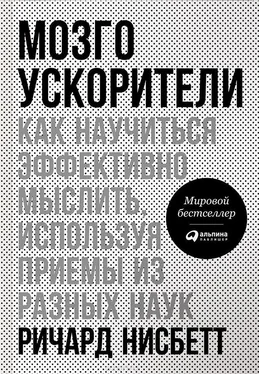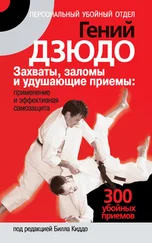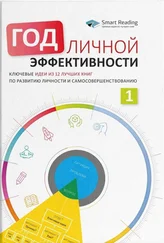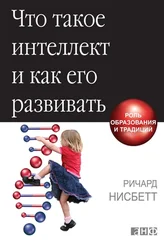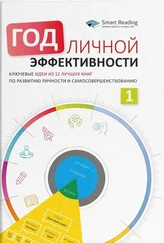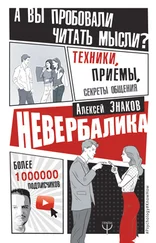Masuda, Takahiko, and Richard E. Nisbett. “Attending Holistically Vs. Analytically: Comparing the Context Sensitivity of Japanese and Americans.” Journal of Personality and Social Psychology 81 (2001): 922-34.
Cha, J.-H., and K. D. Nam. “A Test of Kelley’s Cube Theory of Attribution: A Cross-Cultural Replication of McArthur’s Study.” Korean Social Science Journal 12 (1985): 151-80.
Choi, Incheol, and Richard E. Nisbett. “Situational Salience and Cultural Differences in the Correspondence Bias and in the Actor-Observer Bias.” Personality and Social Psychology Bulletin 24 (1998): 949-60.
Нисбетт Р. География мысли. — М.: Астрель, 2011
Nisbett, Richard Е., and Timothy De Camp Wilson. “Telling More Than We Can Know: Verbal Reports on Mental Processes.” Psychological Review 84 (1977): 231-59.
Tide (англ.) — прилив. — Прим. пер.
Zajonc, Robert B. “The Attitudinal Effects of Mere Exposure.” Journal of Personality and Social Psychology 9 (1968): 1-27.
Bargh, John A., and Paula Pietromonaco. “Automatic Information Processing and Social Perception: The Influence of Trait Information Presented Outside of Conscious Awareness on Impression Formation.” Journal of Personality and Social Psychology 43 (1982): 437-49.
Karremans, Johan C., Wolfgang Stroebe, and Jasper Claus. “Beyond Vicary’s Fantasies: The Impact of Subliminal Priming and Brand Choice.” Journal of Experimental Social Psychology 42 (2006): 792-98.
Chartrand, Tanya L., J. Huber, B. Shiv, and R. J. Tanner. “Nonconscious Goals and Consumer Choice.” Journal of Consumer Research 35 (2008): 189-201.
Berger, Jonah, and Grainne M. Fitzsimons. “Dogs on the Street, Pumas on Your Feet.” Journal of Marketing Research 45 (2008): 1-14.
Buss, David M. The Murderer Next Door: Why the Mind Is Designed to Kill. New York: Penguin, 2006.
Wilson, Т. D., J. W. Schooler. “Thinking Too Much: Introspection Can Reduce the Quality of Preferences and Decisions.” Journal of Personality and Social Psychology 60 (1991): 181-92.
Dijksterhuis, Ap, and Loran F. Nordgren. “A Theory of Unconscious Thought.” Perspectives on Psychological Science 1 (2006): 95.
Объяснение, которое я (и авторы) предпочитаю давать выбору постера, джема или квартиры, поставлено под сомнение. Я на стороне авторов, но указанные ниже источники расскажут вам о некоторых фактах как за, так и против возможности того, что бессознательное обдумывание вариантов может привести к самому выбору: Aczel et al., “Unconscious Intuition or Conscious Analysis: Critical Questions for the Deliberation-Without-Attention Paradigm”; Calvillo and Penaloza, “Are Complex Decisions Better Left to the Unconscious?”; Dijksterhuis, “Think Different: The Merits of Unconscious Thought in Preference Development and Decision Making”; Dijksterhuis and Nordgren, “A Theory of Unconscious Thought”; A. Dijksterhuis et al., “On Making the Right Choice: The Deliberation- Without-Attention Effect”; Gonzalo et ah, ‘“Save Angels Perhaps’: A Critical Examination of Unconscious Thought Theory and the Deliberation-Without-Attention Effect”; Strick et al., “A Meta-Analysis on Unconscious Thought Effects.”
Lewicki, Pawel, Thomas Hill, and Maria Czyzewska. “Nonconscious Acquisition of Information.” American Psychologist 47 (1992): 796-801.
Klarreich, Erica. “Unheralded Mathematician Bridges the Prime Gap.” Quanta Magazine. May 19, 2013.
Ghiselin, Brewster, ed. The Creative Process. Berkeley and Los Angeles: University of California Press, 1952/1980.
Maier, N. R. F. “Reasoning in Humans II: The Solution of a Problem and Its Appearance in Consciousness.” Journal of Comparative Psychology 12 (1931): 181-94.
Kim, Sung Hui. "Naked Self-Interest? Why the Legal Profession Resists Gatekeeping." Florida Law Review 63 (2011): 129-62.
Dunn, Elizabeth W., Laura B. Aknin, and Michael I. Norton. “Spending Money on Others Promotes Happiness.” Science 319 (2008): 1687-88.
Borgonovi, Francesca. “Doing Well by Doing Good: The Relationship Between Formal Volunteering and Self-Reported Health and Happiness.” Social Science and Medicine 66 (2008): 2321-34.
Heckman, James J. "Skill Formation and the Economics Investing in Disadvantaged Children." Science 312 (2006): 1900-1902
Sunstein, Cass R. "The Stunning Triumph of Cost-Benefit Analysis." Bloomberg View (2012). Published electronically September 12, 2012.
Appelbaum, Binyamin. “As U.S. Agencies Put More Value on a Life, Businesses Fret.” The New York Times. Published electronically February 16, 2011.
NBC News. “How to Value Life? EPA Devalues Its Estimate.” Published electronically July 10, 2008.
Appelbaum, Binyamin. “As U.S. Agencies Put More Value on a Life, Businesses Fret.” The New York Times. Published electronically February 16, 2011.
Kingsbury, Kathleen. “The Value of a Human Life: $129,000.” Time. Published electronically May 20, 2008.
Desvousges, William H., et al. “Measuring Non-Use Damages Using Contingent Valuation: An Experimental Evaluation of Accuracy.” In Research Triangle Institute Monograph 92-1. Research Triangle Park, NC: Research Triangle Institute, 1992.
В 1977 г. появились сообщения, что при ударе в заднюю часть кузова Pinto топливный бак может быть пробит, что приведет к возгоранию. Позже эта информация была опровергнута. — Прим. пер.
Hardin, Garrett. “The Tragedy of the Commons.” Science 162 (1968): 1243-45.
Larrick, Richard P., J. N. Morgan, and R. E. Nisbett. “Teaching the Use of Cost-Benefit Reasoning in Everyday Life.” Psychological Science 1 (1990): 362-70. Larrick, Richard P., R. E. Nisbett, and J. N. Morgan. “Who Uses the Cost-Benefit Rules of Choice? Implications for the Normative Status of Microeconomic Theory.” Organizational Behavior and Human Decision Processes 56 (1993): 331-47.
Larrick, Richard P., R.E. Nisbett, and J.N. Morgan. “Who Uses the Cost-Benefit Rules of Choice? Implications for the Normative Status of Microeconomic Theory.” Organizational Behavior and Human Decision Processes 56 (1993): 331-47.
Читать дальше
Конец ознакомительного отрывка
Купить книгу
